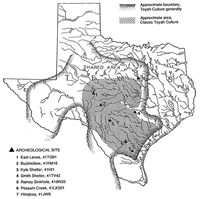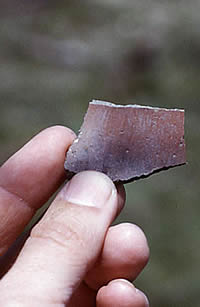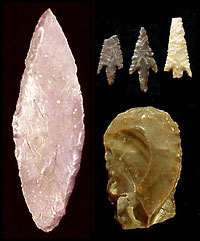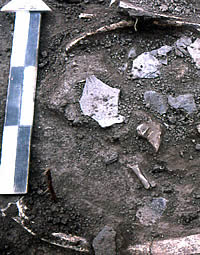Toyah Culture
A distinctive archeological culture emerges around A.D. 1300-1350 throughout the Edwards Plateau and beyond that is variously known as the Toyah phase, horizon, interval, or culture. Over much of the region, Toyah culture represents the last widespread prehistoric pattern prior to the arrival of Europeans. The appearance and rapid spread of Toyah culture is thought to be strongly linked to the return of bison herds into the Southern Plains including all of the Edwards Plateau and much of the Rio Grande Plains to the south. Toyah culture is only sparsely represented in the Lower Pecos canyonlands, but is well documented at many sites across the Plateau and Balcones Canyonlands.
Bison bones, which are largely absent from sites dating to the seven centuries immediately preceding Toyah, are common or at least present in most Toyah sites. This reappearance of bison has led some archeologists to characterize Toyah as a bison-hunting culture. This simple characterization, like most, is misleading. There is, in fact, good evidence that many traditional aspects of prehistoric life in the region, such as plant baking, remain little changed. Burned rock midden accumulation continued apace in many places during the Toyah interval as did deer hunting.
So what makes Toyah culture distinctive? Two sets of things are particularly evident in the archeological record; namely, the seemingly sudden appearance and rapid spread of a unique stone toolkit and of earthenware pottery. The Toyah toolkit includes the Perdiz arrow point, beveled knives, end scrapers, and drills made on flakes. This toolkit was well suited for hunting (Perdiz points), butchering (beveled knives), and processing the hides (end scrapers) of bison as well as deer and antelope. In addition, blade technology reappears in the region after an absence of over 12,000 years (since Clovis times). Not all Toyah groups adopted blade technology, but many did and they probably did so mainly because this flintknapping technique allowed toolmakers to yield more useful pieces (blades—parallel-sided flakes struck from a specially prepared core) than was possible with conventional flintknapping methods. Perdiz points, flake tools, and small end scrapers were all made from blades (as well as ordinary flakes).
Toyah peoples also adopted the habit of pottery making which had heretofore been unknown in the region even though prehistoric groups to the east, west, and north had been making pottery for hundreds of years. Toyah potters made simple earthenware pottery with clay to which they often added pulverized animal bone. This bone-tempered pottery tradition is sometimes known as Leon Plain pottery, but there were probably several different stylistic variations. Some vessels, for instance, were decorated with a red-ochre slip or simple incised decorations. Truthfully, it is often difficult to see stylistic differences—Toyah bone-tempered pottery was fired at very low temperatures, broke easily, and weathered badly when left on the surface. Archeologists typically find only small potsherds (pottery fragments). Whole or reconstructable vessels are extremely rare. By and large, the pottery was utilitarian—most vessels were water jugs (ollas) or simple bowls.
Toyah culture fascinates archeologists because it is distinctive, widespread, and well preserved. The good preservation is simply a matter of elapsed time. Because Toyah was the last widespread prehistoric pattern in the region, Toyah cultural deposits were left more or less undisturbed. In other words, Toyah sites were abandoned and were not reoccuppied by succeeding generations of native peoples. Toyah deposits are less than 700 years old, far younger than most prehistoric deposits in the region. Archeologists enjoy studying a new material type —pottery. Toyah pottery may occur mainly in small pieces, but each of these pieces retain clues as to the origin of the clay, manufacturing methods, and function. Then there is the lure of the return to bison to the region, a subject which has attracted lots of attention.
Even so, Toyah culture is not very well understood. As now defined, Toyah is largely a material culture—a unique set of things seen over a two or three century period across much of the southern half of Texas including the entire Plateaus and Canyonlands region. It is obvious that Toyah material culture was adopted by many different social/ethnic groups who may not have shared much else in common. The relationships among Toyah culture and the earliest Indian groups that Europeans encountered in the 16th century should be strong and obvious, but so far this has not proved to be the case. Toyah culture remains fascinating and worthy of a great deal of thoughtful research because it should bridge the chasm between prehistory and history, between ancient things and living peoples.



